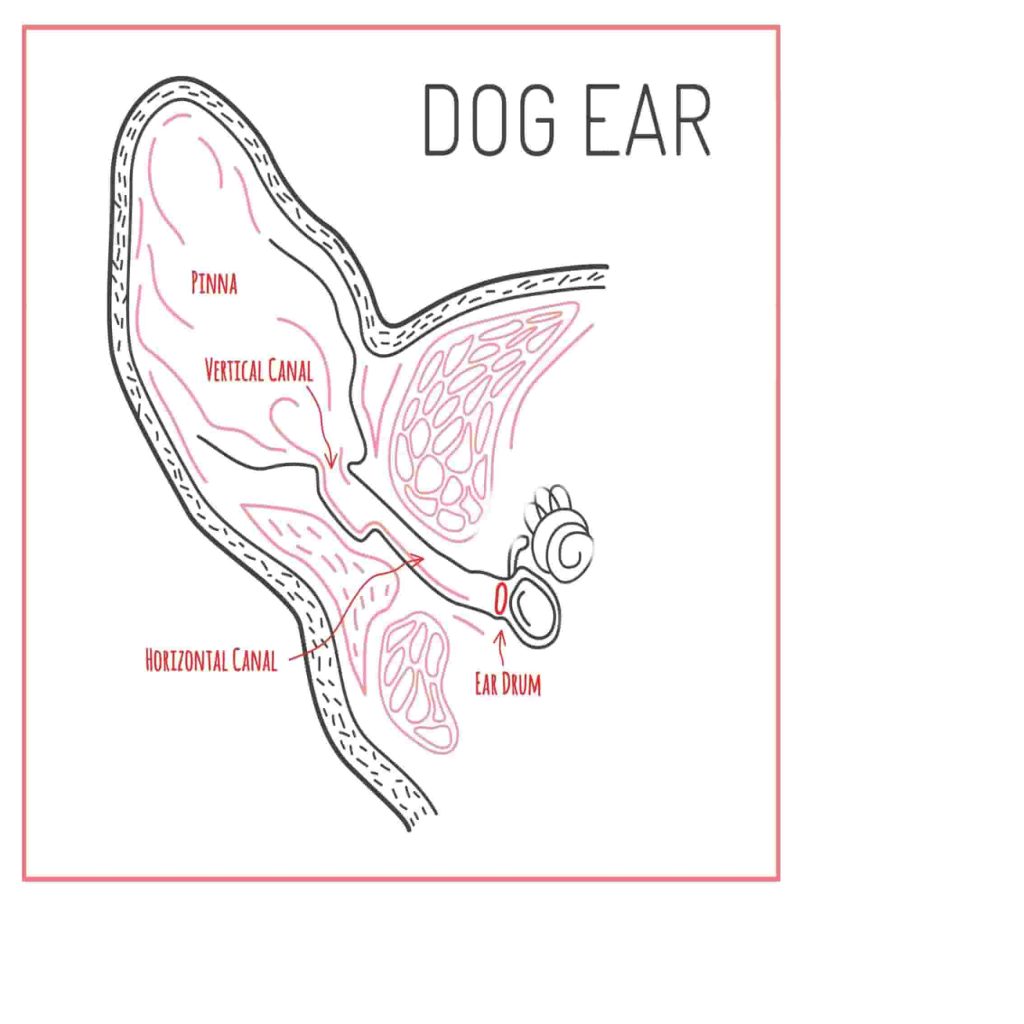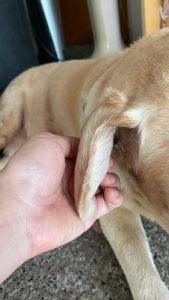An aural haematoma in dogs is a condition where the ear flap fills up with blood. Aural haematomas are fairly common in dogs and have a good outlook if treatment is started as soon as possible and the underlying cause is found.
The most common cause of aural haematomas in dogs is trauma, from excessive head shaking or ear scratching. This is often due to an underlying ear infection or allergies. An aural haematoma is also known as a cauliflower ear, and it can develop at any age in dogs.
Overview
What is an aural haematoma in dogs?
An aural haematoma is a condition where a pocket of blood collects inside the ear flap:
- It is thought that aural haematomas appear due to rupture of the blood vessels that are between the skin and cartilage of the ear flap. This theory is still being investigated.
- Excessive scratching at the ears or shaking of the head due to ear infections or allergies are the most common causes.
- Less commonly, dogs with blood clotting disorders can develop haematomas without any trauma.
- The ear flap appears swollen. The swelling is usually squishy and warm to the touch.
- Aural haematomas are usually easy to diagnose and treat.
- Most cases of aural haematomas clear within a few weeks with appropriate treatment.
- If left untreated, an aural haematoma will lead to thickening and distortion of the ear. This is when it’s known as a “cauliflower ear”.

The most common underlying causes of aural haematomas in dogs are:
- Bacterial and fungal ear infections
- Ear mites
- Allergies: flea, food and environmental
- A foreign body in the ear
- Growths in the ear
- Bite or scratch wounds
Without proper treatment, aural haematomas can lead to long-term thickening and distortion of the ear. They can also cause a lot of pain for your dog. Contact a vet as soon as possible if your dog develops an aural haematoma.
Our Joii Vets are available 24 hours a day for advice. Download the app and call us now.
Symptoms
Symptoms of an aural haematoma in dogs
The most common signs associated with an aural haematoma are:
- Swollen ear flap that is red and hot to the touch
- Droopy ear
- Head tilt
- Scratching at ears
- Head shaking
- Pain
Aural haematomas can affect just one ear or both ears at the same time.

Risk
Are some dogs more at risk of an aural haematoma than others?
Any dog that has itchy or irritated ears is at risk of developing an aural haematoma.
- Dogs with folded-over (V-shaped) or semi-erect ear flaps have a higher risk than others.
- Dogs with allergies also have a higher risk.
- The most common breeds include French Bulldogs, Bull Terriers, and Saint Bernards.
- Larger-breed dogs have a higher risk than smaller dogs
Diagnosis
How is an aural haematoma diagnosed in dogs?
Vets usually diagnose aural haematomas based on how the ear looks and feels. The following tests can help diagnose underlying conditions:
- An otoscopic exam of the ear (looking down the canal with a special ear instrument)
- Ear swab and flush
- Biopsy of any growths in the ear
- Flea paper test
- Food trial
- Allergy testing: blood or intradermal
Vet treatment
What’s the treatment for an aural haematoma in dogs?
There are several options for treating haematomas in dogs. The options depend on how big the haematoma is, if it has happened before, and if your dog is ok with having general anaesthesia. Pain relief medication is always an important part of the treatment.
Medical management of aural haematomas
- This is an option if the haematoma is small and your dog has never had this problem before
- It involves draining the swelling with a needle
- Your vet might inject a medication into the ear flap after removing the blood to reduce inflammation
- Some dogs will require sedation for this
- Oral steroids are a common medication used in medical management
- There is a chance the haematoma will form again soon after being drained
Surgical management of aural haematomas
- Requires general anaesthesia
- The most common treatment for haematomas that come back more than once
- There are many techniques used for surgery of aural haematomas
- Most techniques involve making an incision on the inside of the ear flap. The haematoma is then drained and flushed thoroughly. Stitches (often with pieces of rubber) are put on the ear flap to hold the tissues together. The main incision is left open for drainage.
- A head bandage is usually placed after surgery to prevent any excessive movement of the ear flap.
- The stitches, or drains, are usually kept in for a long period of time, up to a few weeks, and then removed.
Some haematomas will heal without treatment if the underlying cause is found and resolved. However, it often leads to thickening and scarring of the ear. The ear can change shape and block the canal, leading to pain and long-term ear canal problems.
There is almost always an underlying cause, which also requires treatment, along with surgery or drainage of the haematoma. This includes antibiotics for ear infections or anti-itch medication for allergies.
Home treatment
How to look after a dog with an aural haematoma at home
If your dog develops an aural haematoma, it is always advisable to get it checked with a vet. Once on appropriate treatment, you can help manage the condition at home by:
- Using the medication prescribed by your vet. If you struggle giving tablets or putting ear drops in, let your vet know; there are often alternatives available.
- Using a buster collar to prevent scratching at the ear
- Cleaning the ear after surgery, if recommended by your vet
- Monitoring your dog’s ears daily to assess if the symptoms are improving
- Making sure your dog has a quiet place to rest and easy access to water and food
Never try to drain the haematoma by yourself. This can lead to infection and severe pain.
Prevention
Tips on how to prevent an aural haematoma in dogs
Treating the underlying cause of an aural haematoma can reduce the likelihood of it forming.
- Keep your dog up to date with vaccinations and parasite preventatives.
- Check your dog’s ears daily for any signs of redness or discharge.
- Cleaning your dog’s ears can prevent the build-up of wax and reduce the chance of infection. Speak to a vet before doing this to make sure you use the correct product and know how to clean the ear properly.
- If your dog starts scratching their ears or shaking their head, make sure to speak to a vet as soon as possible.
- For dogs with allergies, make sure to thoroughly investigate the type of allergy with your vet
Is my family at risk of catching an aural haematoma?
Aural haematomas in dogs are not contagious to people. None of the underlying causes are known to spread to humans either.
When to worry
When you should be worried about aural haematomas in dogs
An aural haematoma is not an emergency, but we recommend getting them checked with a vet as soon as possible, ideally within 1-2 days.
Seek help from a vet if:
- Your dog has a swollen ear
- Your dog has a painful ear
- Your dog has a head tilt
Call us and speak to one of our Joii vets if:
- You would like advice about preventing ear disease in dogs
- You would like advice about how to clean your dog’s ears








